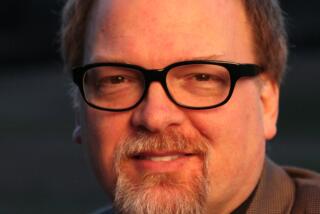Splices in Time and Space : From the Master of the Surreal : THE WESTERN LANDS <i> by William S. Burroughs (Viking: $18.95; 258 pp.) </i>
This final volume of William Burroughs’ trilogy--which includes “Cities of the Red Night” and “The Place of Dead Roads”--illuminates and puts into perspective the whole body of work of the Grand Iconoclast who has altered the concept of the novel more powerfully--some would say “violently”--than any other writer of his time.
Other modern writers have converted the form--Nabokov by working subtly within the frame of the linear novel; Marquez by expanding into an epic the cuento --or tale--by means of filmic techniques. But Burroughs seems to have taken aim at all conventional storytelling--and fired. The results are: fragments of autobiography; smithereens of the adventure novel and the Western; slivers of science fiction, the historical romance and pirate tales; shards of the furious imagery of the most violent books of the Bible, especially the book of Revelations; and even a snippet or two right out of a story from “A Boy’s Life.” Burroughs’ influence has resonated into the world of MTV. His “The Wild Boys” may be the only novel to have been converted (by Duran Duran) into a music video.
Appropriately evoking Chaucer’s and T.S. Eliot’s famous literary journeys--the former through a ribald landscape, the latter through a wasteland--Burroughs here leads us on a pilgrimage to the Land of the Dead, the “Western Lands,” through which Egyptians believed souls voyaged to find immortality.
This book displays all the staples of Burroughs’ staked territory: splices in time and space from the future into Ancient Egypt, from Kansas City to the city of Waghdas; hilarious digressions that wind throughout apocalyptic horrors, a send-up of Gary Cooper and an incident in a room shared with Joe Stalin; a mixture of tones that is right out of “Terry and the Pirates” (“ ‘The Pharaoh waits! Come!’ No time to get dressed, just a hasty robe and here we go again”); and, of course, the “random chaos” of prose that assumes a startling beauty.
The perils encountered on this journey include the familiar--customs checks--and the arcane--venomous cults, vampirical sexuality. (Burroughs’ fascination with the macabre rivals Bosch’s.) Under the iridescence of nuclear emanations, we travel with the usual motley troopers--”hustlers, guides, fixers, travel agents . . . Messiahs”--and Joe the Dead, Kim Carsons, the scribe Neferti.
If this novel does not contain as many dazzling special effects as “Cities of the Red Night,” if it does not exhibit the sustained energy of “The Place of Dead Roads,” it is nonetheless an ideal finish to this masterful trilogy, more introspective than the earlier volumes. Although the vision is as black (“The human condition is hopeless once you have submitted to it by being born . . . almost “), the humor is sharper (“It is essential for immortalists to remember, do not take anything too seriously”).
About “the old writer”--clearly Burroughs himself--we learn at the opening: “After the first novel he started on a second, but he never finished it. Gradually, as he wrote, a disgust for his words accumulated until it choked him.” And so, exploring new words, “William Seward Hall sets out to write his way out of death . . . to reach the western lands . . . to achieve freedom from fear”--and not by “cowering” in his “physical body for eternity.”
“Only those who can leave behind everything they have ever believed in can hope to escape,” he extends; and he warns: “Safety is the most dangerous of all conditions.” He describes his approach: “. . . Imagine that you are dead and see your whole life spread out in a spatial panorama . . . rooms, streets, landscapes, not sequential but arranged in shifting associational patterns. Your attic room in St. Louis opens into a New York loft, from which you step into a Tangier Street. . . . Instead of crossing the river, bring the people on the other side to your side, where you know the country.” In his work, Burroughs has guided us over to his distinct country.
His own journey has not been easy. “Naked Lunch,” the novel in which he first explored his new forms, had to fight its way through courtrooms to be allowed publication in the United States. Although championed by important literary voices, it was also widely excoriated, ridiculed. In the following years, Burroughs was ignored or relegated to the fringes, unreviewed. Now he is a member of the American Academy of Arts and Letters.
In this book, as in all his work, there is a recurring banality of tone--which, however, often explodes into awesome prose to create a grand effect. There are, too, the lofty pronouncements, an irksome “nuclear mysticism”--but these are often saved by a wonderful twist of syntax that is purely Burroughs’: “For man is indeed the final product. Not because homo sap is the apogee of perfection . . . but because man is an unsuccessful experiment, caught in a biologic dead end and inexorably headed for extinction. ‘All right, boys, let’s cut our way to freedom.’ ” Cliches recur--but they do capture an exactly modern sound.
At his best, he dazzles--and this trilogy ends with a superb passage of autobiographical memory wafting in and out of surrealism, all melding into a slow, elegiac fade.
Whatever his position may ultimately be in the highest ranks of modern writers, William Burroughs has a definite place in that hierarchy. No other writer of his time has asserted a more individual artistic vision and voice.
More to Read
Sign up for our Book Club newsletter
Get the latest news, events and more from the Los Angeles Times Book Club, and help us get L.A. reading and talking.
You may occasionally receive promotional content from the Los Angeles Times.







